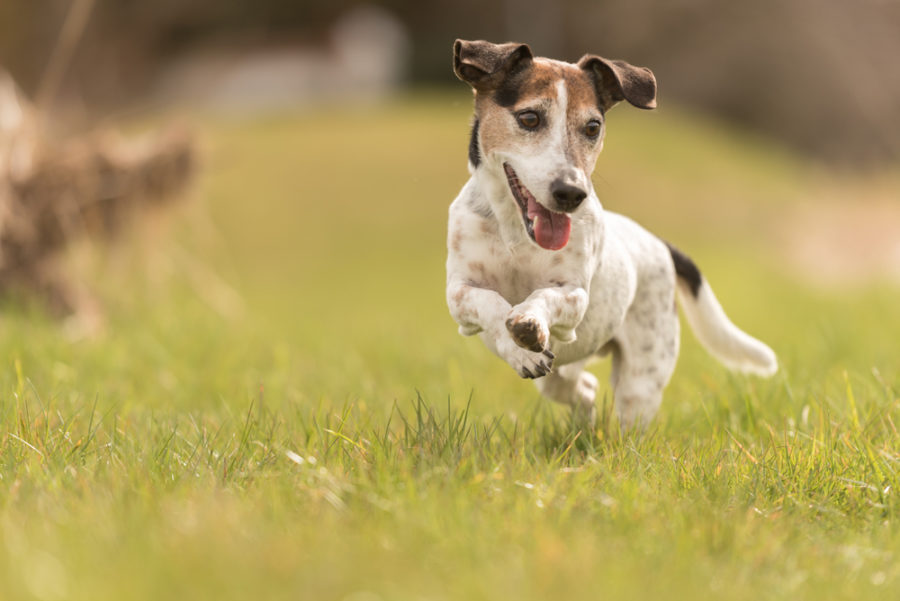Senior dogs need less exercise than their younger counterparts, but that doesn’t mean they should be sedentary! These tips will help you adjust your dog’s exercise routine as he ages.
When dogs grow old, they naturally tend to slow down. Giving him more time to relax is encouraged, but if you let your senior canine be too still and adapt to a sedentary lifestyle, he might experience some health issues. For example, one of the first ailments that inflicts senior dogs that stop or radically decrease their exercise time is obesity. In order to keep your dog fit and healthy into his golden years, it’s important to adapt and maintain his exercise routine. Here’s how!
1. See your veterinarian
Before you turn your dog’s new sedentary lifestyle upside down, see a veterinarian to rule out or address possible health conditions that occur in senior dogs. Have your dog tested for diabetes, osteoarthritis, heart disease and dementia. These are all common health conditions that might be causing your dog to be more inactive than usual.
If your dog has one or more of these conditions, you’ll probably have to consider some specific factors when readjusting his exercise routine. In this case, ask your vet what he or she recommends. If your dog is perfectly healthy and doesn’t show any signs of disease, then you can start easing him into some modified activities (see sidebar on page xx).
Chances are, your veterinarian will also remind you about the importance of diet. Often, because senior dogs are less active, they don’t need to consume as many calories as they did when they were puppies or adults. They also might need different minerals and vitamins to keep their health at peak.
2. Take it slow
If your dog is used to being inactive, don’t start too intensely. Treat him gently and don’t expect him to start running for hours if he’s been a couch potato for the last few months.
Pay attention to your dog’s heart rate, breathing and behavior when you introduce more intense exercise. This is especially important on days when you increase the length of time spent exercising.
3. Pay attention to the environment
Senior dogs might be more sensitive to climate changes, so it’s crucial to consider external factors before you take your aging canine out to exercise. This rule applies to all dogs, but it is especially important for seniors that have difficulty breathing.
Don’t overexercise your dog on days when it’s extremely hot, cold, or humid. All dogs can overheat or get hypothermia, but the risk increases as your dog gets older. On these days, take your dog on short walks, and make sure you know the signs of hypothermia and heat stroke in order to save your dog from dangerous situations.
4. Introduce warm ups
Due to joint problems or bone conditions that develop in senior dogs, it is quite normal for them to be stiff – especially first thing in the morning. Before exercising your dog, let him loosen up by taking a few laps around the yard. Encourage him to wander by walking around with him, or hide low-calorie treats in the grass for him to sniff out.
After 2–3 minutes of walking, your pooch will be ready to exercise.
5. Choose low impact activities
If your dog has been diagnosed with arthritis, he’s not alone. According to a UK study, 80% of dogs develop arthritis by the age of eight. Therefore, almost all dog owners will have to learn to manage it at some point. Although it might break your heart to know your dog feels discomfort in his bones and joints when he moves, this doesn’t mean all activities should end.
 On the contrary, moderate and low impact activities will actually help your dog handle arthritis better. Switch between swimming, walking and low-intensity play sessions. This way you won’t put too much pressure on your dog’s joints while providing him with enough exercise to keep his muscles, bones and joints strong. Avoid activities that involve too much jumping or jogging as they can make things worse.
On the contrary, moderate and low impact activities will actually help your dog handle arthritis better. Switch between swimming, walking and low-intensity play sessions. This way you won’t put too much pressure on your dog’s joints while providing him with enough exercise to keep his muscles, bones and joints strong. Avoid activities that involve too much jumping or jogging as they can make things worse.
6. Keep workouts mentally stimulating
Since dogs can suffer from dementia too, it is important to keep their brains stimulated every day and as often as possible. The best way to assure your dog has enough mental stimulation is by including it in his everyday exercise routine.
For example, use your outdoor time to teach your dog some new tricks. Visit a dog park and socialize your pooch with new dogs, or introduce some nose work games. As long as you engage your dog’s senses, he’ll find any game amusing!
7. Massage after exercise
If you haven’t tried massaging your dog yet, it could be the right time to start! Introduce 10-minute massage sessions after exercise to decrease stiffness and pain in your dog’s joints and improve circulation in his muscles.
Dog massage is a very simple thing to do. Just be careful not to be too rough, and everything else should flow quite naturally. You may notice that massaging your dog has the same calming effect on him than it does on you! If you can’t do it every day, at least introduce massages a couple times a week. Your dog will surely be thankful!








